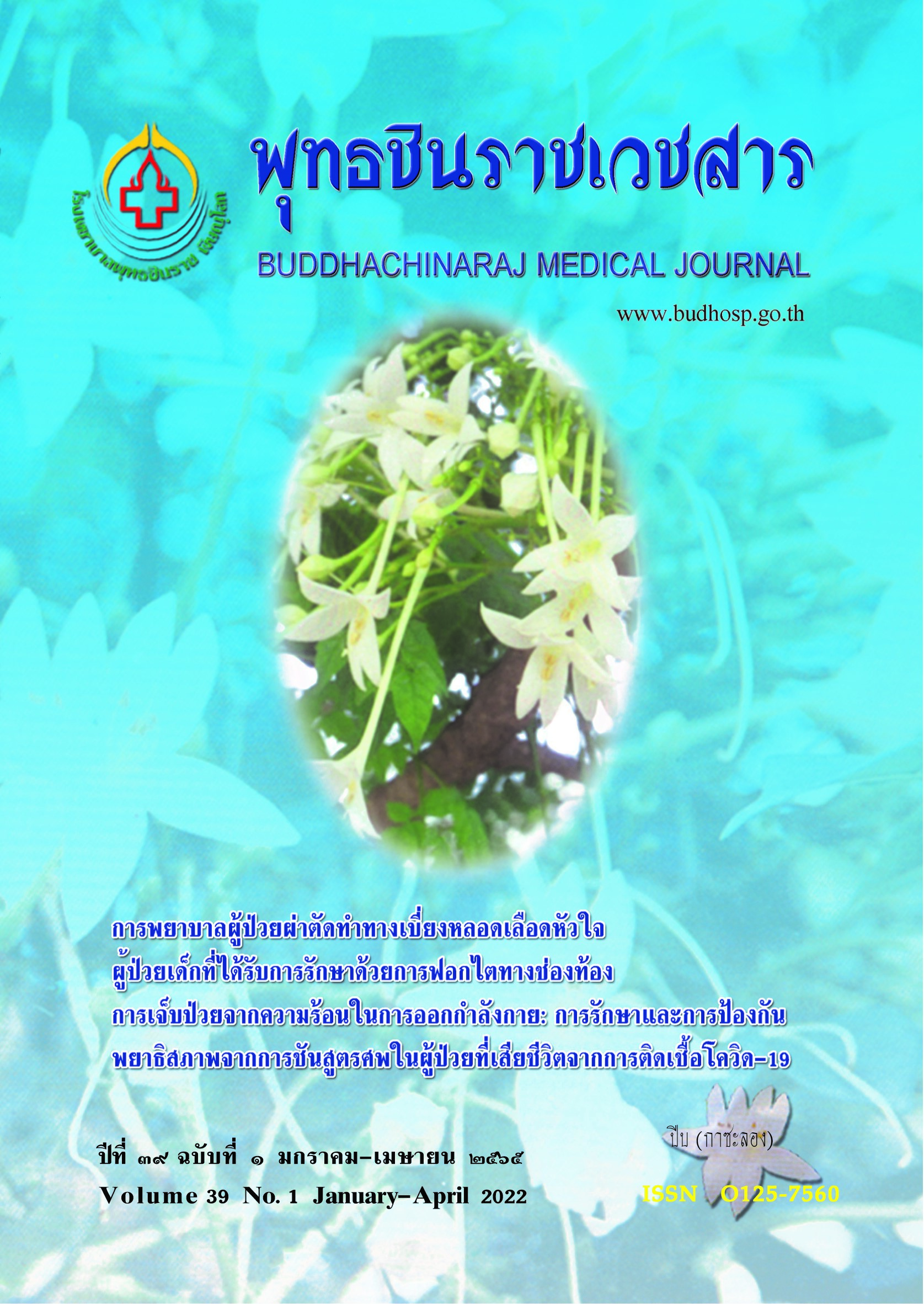ผลของการใส่ท่อช่วยหายใจแบบรวดเร็วโดยใช้ยานำสลบและยาคลายกล้ามเนื้อ ร่วมกับกล่องกันเชื้อฟุ้งกระจาย ณ แผนกฉุกเฉิน
ผลของการใส่ท่อช่วยหายใจแบบรวดเร็ว
คำสำคัญ:
การใส่ท่อช่วยหายใจแบบรวดเร็วโดยใช้ยานำสลบและยาคลายกล้ามเนื้อ, แผนกฉุกเฉิน, อัตรา ความสำเร็จ, กล่องกันเชื้อฟุ้งกระจายบทคัดย่อ
การใส่ท่อช่วยหายใจแบบรวดเร็วโดยใช้ยานำสลบร่วมกับยาคลายกล้ามเนื้อ (rapid sequence intubation: RSI) ถือเป็นวิธีมาตรฐานในการใส่ท่อ ช่วยหายใจที่แผนกฉุกเฉิน พบว่ามีโอกาสสำเร็จสูง และเกิดภาวะแทรกซ้อนต่ำกว่าเมื่อเทียบกับการใส่ ท่อช่วยหายใจด้วยวิธีดั้งเดิม (non-RSI) จากการ ระบาดของไวรัสโคโรนา 2019 จึงใช้กล่องกันเชื้อฟุ้ง กระจายครอบขณะใส่ท่อช่วยหายใจทุกครั้งเพื่อ ป้องกันการติดเชื้อสู่บุคลากร การวิจัยกึ่งทดลองนี้มี วัตถุประสงค์เพื่อเปรียบเทียบผลการใส่ท่อช่วย หายใจสำเร็จ ระยะเวลา และภาวะแทรกซ้อนระหว่าง วิธี RSI กับ non-RSI ศึกษาในผู้ป่วยที่ได้รับการใส่ ท่อช่วยหายใจร่วมกับกล่องกันเชื้อฟุ้งกระจาย 100 คน ณ แผนกฉุกเฉิน แบ่งเป็นผู้ป่วยกลุ่มทดลองและกลุ่มควบคุมกลุ่มละ 50 คน โดยกลุ่มทดลองใช้วิธี RSI กลุ่มควบคุมใช้วิธี non-RSI ผลการวิจัยพบว่า กลุ่มที่ใส่ท่อช่วยหายใจด้วยวิธี RSI มีอัตราการใส่ท่อช่วยหายใจสำเร็จสูงกว่าและใช้ระยะเวลาในการใส่ ท่อช่วยหายใจสั้นกว่ากลุ่ม non-RSI อย่างมีนัย สำคัญทางสถิติ (p = 0.023, < 0.001 ตามลำดับ) แต่ การเกิดภาวะแทรกซ้อนไม่แตกต่างกันระหว่างสอง กลุ่มสรุปได้ว่า การใส่ท่อช่วยหายใจวิธี RSI ร่วมกับ กล่องกันเชื้อฟุ้งกระจายสามารถทำได้อย่างรวดเร็ว มีอัตราสำเร็จสูงกว่าเมื่อเทียบกับวิธี non-RSI ควรนำ วิธีใส่ท่อช่วยหายใจด้วยวิธ ีRSI มาเป็นแนวปฏิบัติที่ แผนกฉุกเฉินเพื่อเพิ่มคุณภาพในการดูแลผู้ป่วยวิกฤติ ต่อไป
เอกสารอ้างอิง
Hasegawa K, Shigemitsu K, Hagiwara Y, Chiba T, Watase H, Brown CA, et al. Association between repeated intubation attempts and adverse events in emergency departments: an analysis of a Multicenter Prospective Observational Study. Ann Emerg Med 2012;60(6):749-54.e2. doi:10.1016/j.annemergmed.2012.04.005
Brown CA, Walls RM. Rapid sequence intubation. In: Brown CA, Sakles JC, Mick NW, editors. The Walls manual of emergency airway management. 5th ed. Philadelphia, Pennsylvania State, USA:Wolters Kluwer Health; 2017. p.360-80.
Brown CA, Walls RM. Airway. In: Wall RM, Hockberger RS, Gausche-Hill M, editors. Rosen's emergency medicine concepts and clinical practice. 9th ed. Philadelphia, Pennsylvania State, USA: Elsevier Health Sciences; 2017. p.3-23.
Wongyingsinn M, Surabenjawong U. A prospective controlled of the rapid sequence intubation technique in the Emergency Department of a University Hospital. J Med Assoc Thai 2017;100(9):953-9.
Hagberg CA, Artime CA. Airway management in the adult. In: Miller RD, Cohen NH, Eriksson LI, Fleisher LA, Wiener-Kronish JP, Young WL, editors. Miller's anesthesia. 8th ed. Philadelphia, Pennsylvania State, USA: Saunders; 2015. p.1647-83.
Brown CA, Bair AE, Pallin DJ, Walls RM, NEAR III Investigators. Techniques, success, and adverse events of emergency department adult intubation. Ann Emerg Med 2015;65(4):363-70.e1. doi: 10.1016/j.annemergmed.2014.10.036
Kerslake D, Oglesby AJ, Di Rollo N, James E, McKeown DW, Ray DC, et al. Tracheal intubation in an urban emergency department
in Scotland: a prospective observational study of 3,738 intubations. Resuscitation 2015;89:20-4. doi: 10.1016/j.resuscitation. 2015.01.005
Tayal VS, Riggs RW, Marx JA, Tomaszewski CA, Schneider RE. Rapidsequence intubation at an emergency medicine residency: success rate and adverse events during a two-year period. Acad Emerg Med 1999;6(1):31-7.
Trakulsrichai S, Sundarathiti P, Chalermdamrichai P, Palasatien I, Rattanasiri S, Chatchaipun P, et al. An observational study of rapid sequence, awake and sedation-only intubations in an emergency department in Thai patients. J Med Assoc Thai 2009; 92(8):1022-7.
Heddigard S. Endotracheal intubation in the emergency department of Lampang and Phrae Hospital. Lampang Med J 2012;(33)2:103-14.
Srivilaithon W. Prospective observational study of emergency airway management in emergency department. J Med Assoc Thai 2016;99(Suppl 4):S131-7.
Centers of Disease Control and Prevention. Scientific brief: SARS-CoV-2 transmission [Internet]. 2021 [cite 2021 Oct 1]. Available from: URL:https://www.cdc.gov/coronavirus/2019-ncov/science/science-briefs/sars-cov-2-transmission.html
Jackson T, Deibert D, Wyatt G, Durand-Moreau Q, Adisesh A, Khunti K, et al. Classification of aerosol-generating procedures: a rapid systematic review. BMJ Open Resp Res 2020;7(1):e000730. https://bmjopenrespres. bmj.com/content/7/1/e000730
Canelli R, Connor CW, Gonzalez M, Nozari A, Ortega R. Barrier enclosure during endotracheal intubation. N Engl J Med 2020;382(20):1957-8. doi: 10.1056/NEJMc2007589
Brown CA, Walls RM. Identification of the difficult and failed airway. in: Brown CA, Sakles JC, Mick NW, editors. The Walls manual of emergency airway management. Philadelphia, Pennsylvania State, USA:Wolters Kluwer Health; 2017. p.32-53.
Kim C, Kang HG, Lim TH, Choi BY, Shin YJ, Choi HJ. What factors affect the success rate of the first attempt at endotracheal intubation in emergency departments? Emerg Med J 2013;30(11):888-92. doi:10.1136/emermed-2012-201708
Natt BS, Malo J, Hypes CD, Sakles JC, Mosier JM. Strategies to improve first attempt success at intubation in critically ill patients. Br J Anaesth 2016;117(Suppl 1):i60-i68. doi: 10.1093/bja/aew061
Simpson JP, Wong DN, Verco L, Carter R, Dzidowski M, Chan PY. Measurement of airborne particle exposure during simulated tracheal intubation using various proposed aerosol containment devices during the COVID-19 pandemic. Anaethesia 2020;75(12):1587- 95. doi: 10.1111/anae.15188
Begley JL, Lavery KE, Nickson CP, Brewster DJ. The aerosol box for intubation in coronavirus disease 2,019 patients: an in-situ simulation crossover study. Anaesthesia 2020;75(8):1014-21. doi: 10.1111/anae. 15115
Lim ZJ, Reddy MP, KaralapillaiD, Shekar K, Subramaniam A. Impact of an aerosol box on time to tracheal intubation: systematic review and meta-analysis. Br J Anaesth 2021;126(3):e122-e125. doi: 10.1016/j.bja.2020.11.036
Nakornchai T, Limphan-Udom P, Monsomboon A, Surabenjawong U, Praphruetkit N, Chaisirin W, et al Factors associated with post- intubation hypotension in an emergency department: a retrospective observational study. J Med Assoc Thai 2017;100(8):864-71.
Lin CC, Chen KF, Shih CP, Seak CJ, Hsu KH. The prognostic factors of hypotension after rapid sequence intubation. Am J Emerg Med 2008;26(8):845-51.
ดาวน์โหลด
เผยแพร่แล้ว
ฉบับ
ประเภทบทความ
สัญญาอนุญาต
ลิขสิทธิ์ (c) 2022 พุทธชินราชเวชสาร

อนุญาตภายใต้เงื่อนไข Creative Commons Attribution-NonCommercial-NoDerivatives 4.0 International License.






